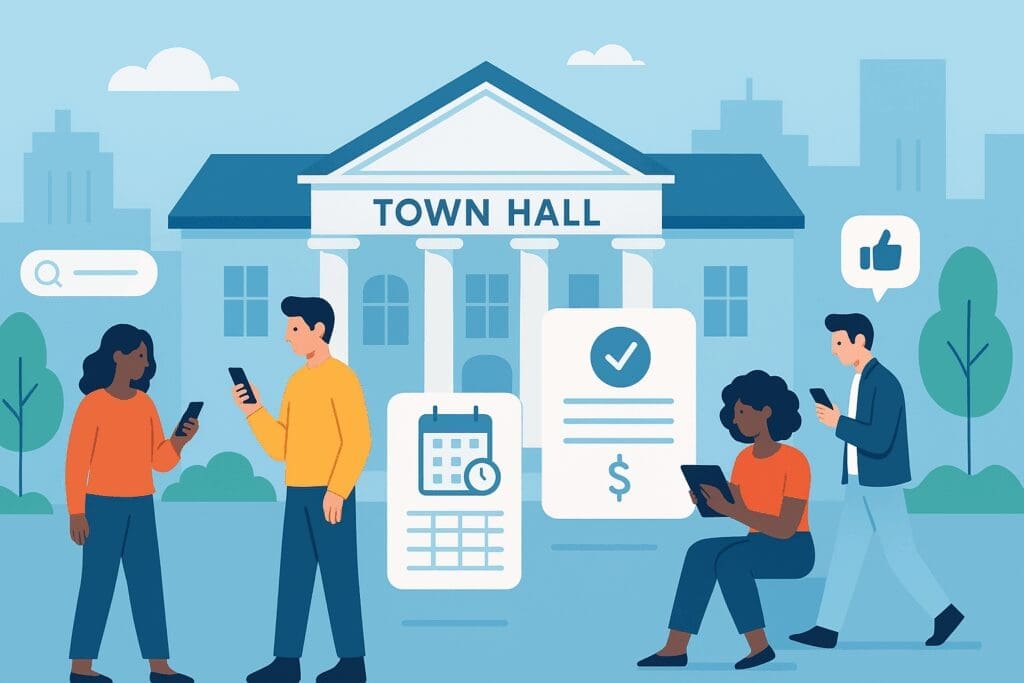A municipality’s website serves as far more than just an online presence—it functions as a digital town square where citizens gather information, access services, and engage with their local government. An effective municipal website combines thoughtful design, accessibility, and practical functionality to meet the diverse needs of an entire community.
Core Principles of Municipal Website Design
User-Centric Design
At the heart of any successful municipal website is a commitment to user-centric design. The platform should be intuitive and easy to navigate regardless of a visitor’s technical expertise. Whether a resident is tech-savvy or just learning to use the internet, they should be able to find what they need without frustration or confusion. Best practices for municipal website design emphasize clear navigation and organized information architecture.
Accessibility for All
Accessibility isn’t optional—it’s essential. Municipal websites must comply with accessibility standards like the Americans with Disabilities Act (ADA) to ensure that all individuals, including those with disabilities, can access vital government information and services. This means implementing features like screen reader compatibility, proper contrast ratios, alternative text for images, and keyboard navigation support. Enhancing ADA compliance ensures your website serves every member of your community.
Mobile-First Approach
With increasing numbers of citizens accessing government information through smartphones and tablets, responsive design has become crucial. A mobile-friendly website automatically adjusts its layout and functionality to provide an optimal viewing experience across all devices, ensuring that residents can access services whether they’re at home on a desktop or on-the-go with their phone.
Clear Information Architecture
Organization matters. Content should be structured logically and easy to locate, with clear contact details for officials prominently displayed, a centralized homepage for important announcements, and well-organized document hosting. Good information architecture reduces citizen frustration and increases engagement with municipal services.
Essential Features Every Municipal Website Needs
Homepage as Central Hub
The homepage acts as the digital front door to your municipality. It should serve as a central hub featuring key information, current news, emergency alerts, and quick links to frequently accessed services. This is where first impressions are made, so clarity and organization are paramount.
Robust Search Functionality
Not every user will navigate through menus to find what they need. A powerful search bar allows residents to quickly locate specific information, documents, or services by entering keywords, dramatically improving the user experience and reducing the time needed to complete tasks.
Community Events Calendar
An integrated events calendar keeps citizens informed about town meetings, public hearings, community events, and municipal activities. This feature helps foster community engagement and ensures residents don’t miss important civic opportunities.
Online Payment Systems
Modern municipal websites should enable residents to pay bills and fees online—whether it’s property taxes, utility bills, or permit fees. This convenience simplifies transactions, reduces administrative burden, and provides 24/7 service availability.
Digital Forms and Permits
Gone are the days when residents had to visit city hall for every form or application. Digital forms and permit systems allow citizens to complete and submit paperwork online, streamlining processes like business license applications, building permits, and various registrations.
311 Citizen Reporting System
A 311 citizen reporting system empowers residents to report non-emergency issues like potholes, broken streetlights, or maintenance requests directly through the municipal website. This streamlines government operations and creates a more connected community by providing transparency and real-time updates on service requests.
Document Repository
Transparency builds trust. A comprehensive document repository provides easy access to public records, meeting minutes, budget information, ordinances, and other municipal documents. This feature supports open government principles and keeps citizens informed about how their community is managed.
Social Media Integration
Connecting the municipality’s website with its social media accounts creates additional channels for communication and community engagement. Integration allows for real-time updates, emergency notifications, and more casual interaction with residents.
Accessible Contact Information
Contact details for city or town officials should be clear and easy to find. This includes phone numbers, email addresses, office locations, and hours of operation. Making it simple for residents to reach the right person or department is fundamental to good government service.
Comprehensive FAQ Page
A well-maintained FAQ page addresses common questions and concerns, reducing the volume of inquiries directed to staff while providing residents with immediate answers. This feature improves efficiency for both citizens and municipal employees.
Investing in Your Digital Infrastructure
When considering the cost of municipal website design, it’s important to view it as an investment in better government service delivery rather than just an expense. Modern government website design should incorporate all the essential features discussed above while maintaining scalability for future growth.
Municipal website design templates can provide an excellent starting point, offering customizable solutions that balance professional aesthetics with practical functionality. Top features for municipal websites in 2025 continue to evolve, but the core principles of accessibility, usability, and citizen engagement remain constant.
Conclusion
A well-designed municipal website is an investment in better government service delivery and stronger community engagement. By focusing on user experience, ensuring accessibility, and providing practical functionality, municipalities can create digital platforms that truly serve their residents’ needs. As technology continues to evolve, so too should municipal websites—always with the goal of making government more accessible, transparent, and responsive to the people it serves.
Whether you’re building a new website from scratch or updating an existing platform, understanding what makes a municipal website effective is the first step toward creating a digital presence that genuinely serves your community.




